Adhering to a gluten-free Mediterranean diet offers a unique blend of heart-healthy fats, lean proteins, and fresh produce, all while avoiding the gluten found in many staple grains. This dietary path combines the benefits of the Mediterranean lifestyle with the medical necessity or personal choice to eliminate gluten. White bread and pasta, typically high in gluten and refined carbohydrates, are usually off-limits. However, finding suitable gluten-free alternatives allows individuals to continue enjoying these staples without the associated health risks for those with gluten sensitivities or celiac disease.
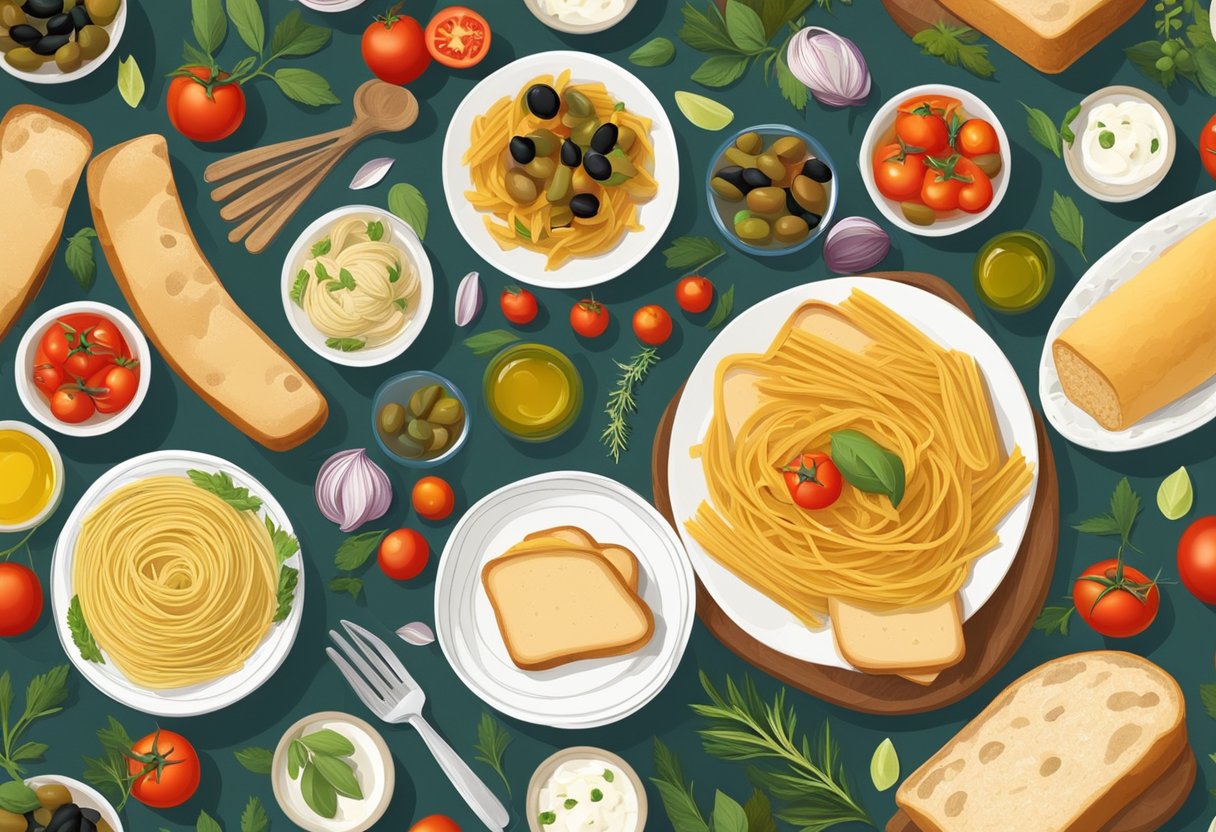
Understanding how to navigate the world of gluten-free grains and pastas is critical to maintaining this diet without feeling deprived. By choosing whole grain, gluten-free options like quinoa, buckwheat, and rice pasta, adherents can recreate the textures and flavors they love. In addition, incorporating a variety of proteins, legumes, and the essential healthy fats found in nuts, seeds, and olive oil can round out meals to remain both satisfying and nutritious. The transition to a gluten-free Mediterranean diet can be smooth with careful planning and an assortment of gluten-free recipes that rework familiar dishes into gluten-free delights.
Key Takeaways
- Gluten-free Mediterranean diet focuses on heart-healthy fats and gluten-free staples.
- Suitable gluten-free replacements for pasta and bread are key to this diet.
- Meal diversity is achieved through proteins, legumes, and healthy fats.
Table of Contents
Essentials of the Gluten-Free Mediterranean Diet
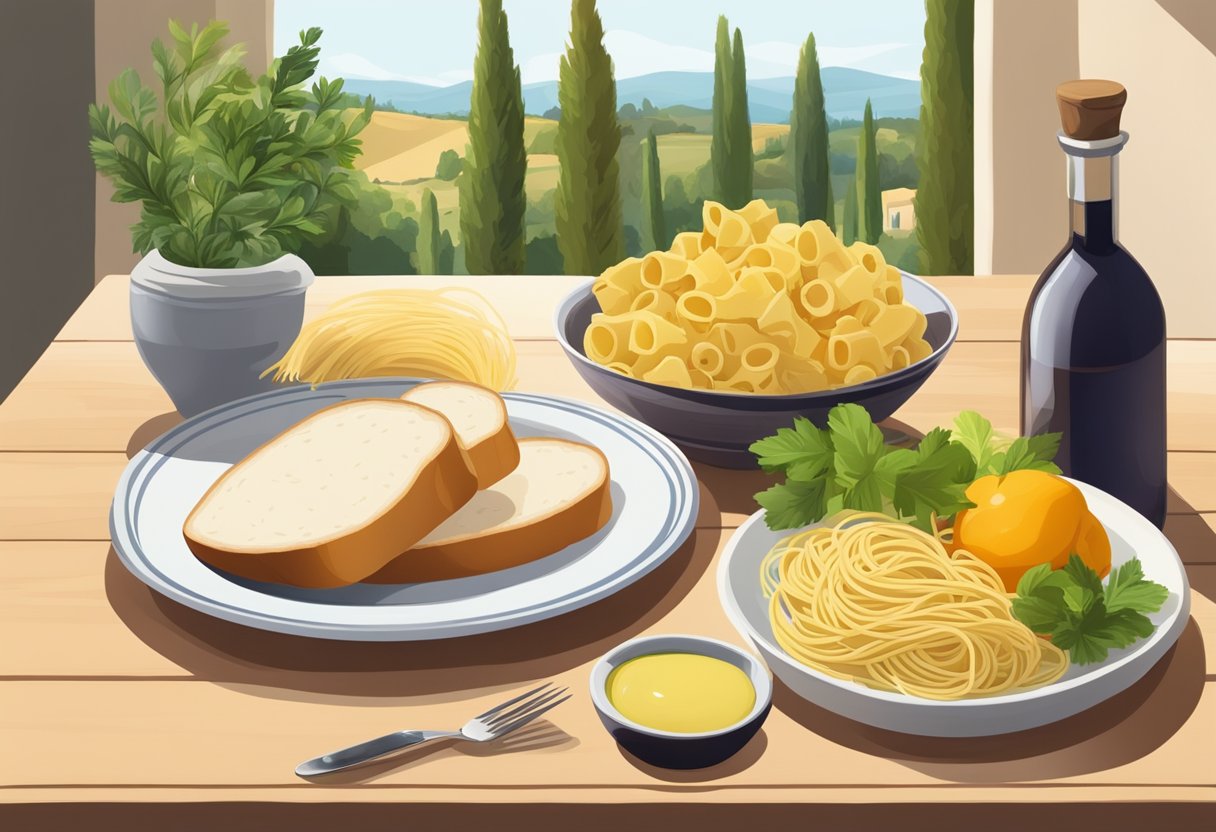
The Gluten-Free Mediterranean Diet merges the heart-healthy principles of the traditional Mediterranean diet with the needs of individuals with celiac disease or gluten sensitivity. It emphasizes natural, unprocessed foods rich in nutrients.
Defining the Diet
The Gluten-Free Mediterranean Diet is a nutritional framework that excludes gluten-containing products while promoting an abundance of fruits, vegetables, lean proteins, and healthy fats. This approach balances the Mediterranean diet’s focus on variety and nutrient-dense foods with strict adherence to gluten-free standards.
Benefits for Health
Adopting a gluten-free Mediterranean diet can lower the risk of heart disease and certain cancers while also benefiting those with chronic conditions by reducing inflammation. It’s designed to be high in fiber and healthy fats, crucial for maintaining good health.
Key Nutrients and Ingredients
Nutrients such as Omega-3 fatty acids, antioxidants, and fiber are central to this diet. Ingredients include vegetables, fruits, olive oil, legumes, nuts, seeds, and naturally gluten-free grains. Proteins come from fish, poultry, and occasionally red meats.
Gluten-Free Mediterranean Food Pyramid
Grains: Gluten-free whole grains like quinoa and rice
Vegetables & Fruits: The base of every meal
Proteins: Fish, legumes, and lean meats; less frequently, poultry and eggs
Fats: Primarily from olive oil, nuts, and seeds
Adapting Tradition to Gluten-Free
Traditional pasta and bread can be substituted with gluten-free pasta and gluten-free bread. Innovation in food processing has allowed for a variety of wholesome and tasty alternatives to be available.
Maintaining Nutritional Value in Gluten-Free Choices
When selecting gluten-free products, it is vital to look for those that match the nutritional value of their gluten-containing counterparts, focusing on fiber content and absence of added sugars or fats.
Consulting the Experts
It is recommended to consult with a registered dietitian to ensure dietary needs are met, especially when constructing a personalized Mediterranean diet meal plan that aligns with gluten-free standards.
Navigating Grains and Pastas
Adopting a gluten-free Mediterranean diet requires careful selection of grains and pastas. Finding nutritious and delicious alternatives to traditional wheat-based staples is essential for maintaining variety and health benefits in your meals.
Safe Gluten-Free Grains
Gluten-free grains such as rice, buckwheat, and quinoa serve as excellent bases for Mediterranean dishes. These grains provide a similar textural experience to traditional pasta and are sources of valuable fiber and carbohydrates.
Choosing the Right Gluten-Free Pasta
Not all gluten-free pastas are created equal. Opting for those made from whole grains can enhance the nutritional value of a meal. Look for gluten-free pasta labels that list rice, quinoa, or buckwheat as primary ingredients to ensure a healthier choice.
Bread Alternatives on the Gluten-Free Diet
Conventional white bread is off-limits on a gluten-free diet, but alternatives abound. Gluten-free bread, including options like those made from almond or coconut flour, can be incorporated. Sourdough bread made from gluten-free flours is another option, providing a distinctly Mediterranean flavor.
Incorporating Nutritious Flours
Almond flour and coconut flour are not only gluten-free but also add richness and texture to recipes. These flours can be used in a variety of baked goods and are a good source of healthy fats and protein.
Understanding Gluten-Free Labels and Additives
It’s imperative to read labels carefully for hidden sources of gluten. Products labeled as gluten-free must comply with specific FDA regulations ensuring they contain less than 20 ppm of gluten. Watch for additives that may contain gluten or affect the overall healthiness of the product.
The Importance of Whole Grains and Gluten-Free Options
Whole grains are a cornerstone of the Mediterranean diet, offering vital nutrients and fibers. Embracing gluten-free whole grains ensures the maintenance of a balanced diet rich in fibers without the gluten found in products like traditional whole-wheat pasta.
Recipes and Meal Ideas

Navigating a gluten-free Mediterranean diet is straightforward with a meal plan that emphasizes fresh ingredients and wholesome options for every meal of the day. The recipes and meal ideas below are designed to suit various times and tastes, always focusing on the delicious blend of gluten-free options and Mediterranean flavors.
Hearty Breakfasts
For breakfast, those on a gluten-free Mediterranean diet can savor Olive Oil Fried Eggs with a side of Sautéed Vegetables. Gluten-Free Oats make a versatile option, either as a warm porridge enriched with nuts and fruits or as overnight oats mixed with almond milk and seeds.
Lunch Suggestions
Lunch can be a vibrant affair with Quinoa Tabbouleh, packed with parsley, mint, tomato, and cucumber, dressed with lemon juice and olive oil. Another quick lunch is a Mediterranean Pasta salad using gluten-free pasta, tossed with olives, feta, and fresh vegetables.
Dinner Delights
For dinner, plates might feature a Grilled Salmon or Shrimp dressed in a citrusy olive oil marinade. Alternately, one can enjoy a spin on the traditional with Gluten-Free Chicken Falafel, served alongside a crisp Green Salad.
Snacks and Sides
Gluten-free diners can reach for snacks like Hummus with sliced vegetables or mixed nuts and seeds for a nutrient-dense bite. Sides may include Roasted Vegetables drizzled with olive oil or lemon juice for an added zest.
Salads and Dressings
A classic Greek Salad—sans gluten-containing ingredients—or a Lentil Salad with a generous pour of olive oil can serve as a standalone meal or an accompaniment. Homemade dressings using olive oil and lemon juice enhance fresh salads without the worry of hidden gluten.
Healthy Alternatives to Traditional Mediterranean Dishes
Traditional Mediterranean favorites are easily modified to be gluten-free. Try replacing standard couscous with Gluten-Free Grains like quinoa, or opt for Gluten-Free Flatbreads to scoop up flavorful dips and spreads.
Incorporating Proteins and Legumes
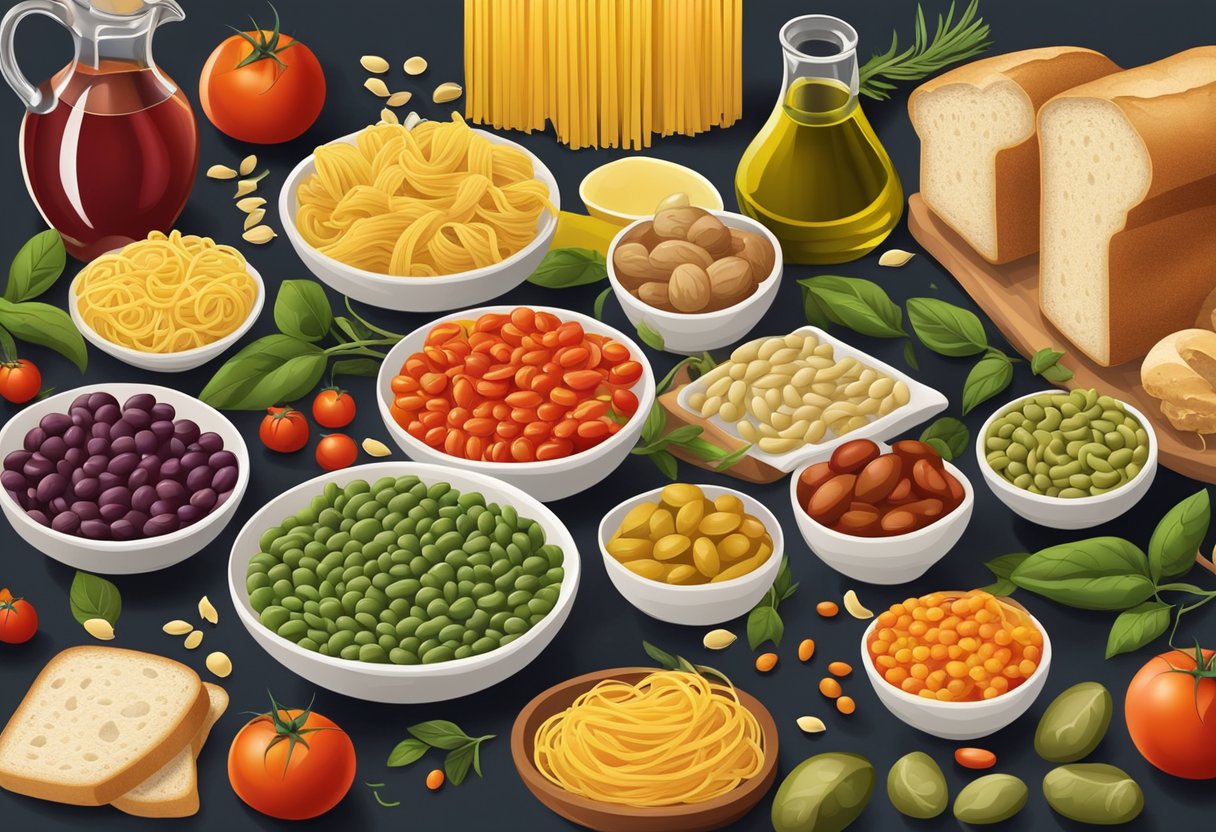
Within a gluten-free Mediterranean diet, proteins and legumes play a crucial role in not only providing essential nutrients but also in diversifying meal options. This section will detail the significance of proteins, the variety of legumes suitable for the diet, and how dairy such as cheese and yogurt fits into this eating pattern.
The Role of Protein in the Mediterranean Diet
Proteins are foundational in the Mediterranean diet and are obtained from both animal and plant sources. Fish, a staple protein source, offers omega-3 fatty acids beneficial for heart health. White meats like chicken are also popular due to their lean quality and versatility in dishes. On a gluten-free Mediterranean diet, these proteins become even more integral as they replace foods that contain gluten like bread and pasta.
Legume Varieties and Preparations
Legumes are vital sources of plant-based protein and are naturally gluten-free. Here are some commonly used legumes and their preparations:
- Chickpeas: Can be made into hummus or added to salads and stews.
- Lentils: Ideal for soups or cold salads.
- Beans: Include various types such as kidney, black, and white beans, which are great in chili or as part of a bean salad.
Each of these legumes provides not only protein but also fiber, vitamins, and minerals.
Cheese and Yogurt: Dairy in the Gluten-Free Mediterranean Diet
Dairy products such as cheese and yogurt contribute to the protein content in the Mediterranean diet and can be safely included in a gluten-free regimen:
- Cheese: Varieties like feta and parmesan add robust flavor to dishes. They can be sprinkled over salads or integrated into vegetable bakes.
- Yogurt: It is often used as a base for dips or as a tangy complement to nuts and fruits.
Both cheese and yogurt provide calcium and are considered probiotic foods, supporting digestive health.
Vegetables, Fruits, and Healthy Fats

In adhering to a gluten-free Mediterranean diet, one’s focus shifts to the bounty of the earth—vegetables, fruits, and healthy fats play pivotal roles in every meal. These ingredients not only offer an array of flavors but are also crucial for maintaining a balanced diet.
Seasonal Vegetables in the Mediterranean Palate
The Mediterranean region is renowned for its diverse range of vegetables. Staples such as zucchini, spinach, and artichokes are not only versatile in recipes but are also dense in nutrients. For example, zucchini is a source of vitamin A, while spinach provides ample iron. Tomatoes, a fruit often treated as a vegetable, are another fundamental component. They bring lycopene and vitamin C into dishes and are a main ingredient in many Mediterranean sauces and salads.
Fresh Fruits and Their Place in the Diet
Fruits in the Mediterranean diet are often consumed fresh and in season, ensuring maximum flavor and nutritional value. Citrus fruits, such as lemons, are widely used not just as a fruit to be eaten or juiced, but also as an acid to balance and brighten dishes. Similarly, the tomato, rich in vitamin C and potassium, is a versatile staple in the kitchen, integral to many salads and as a base for sauces.
Olive Oil and Other Nutritious Fats
Central to the gluten-free Mediterranean diet is the use of olive oil—a heart-healthy fat that is utilized in almost every dish, from salads to cooked vegetables. This oil is not only revered for its flavor but also for its abundance of monounsaturated fats. Beyond olive oil, nuts like almonds and walnuts are incorporated into the diet, providing additional healthy fats along with protein and fiber. These ingredients enhance meals with both texture and nutritional substance.
Dining Out and Social Eating
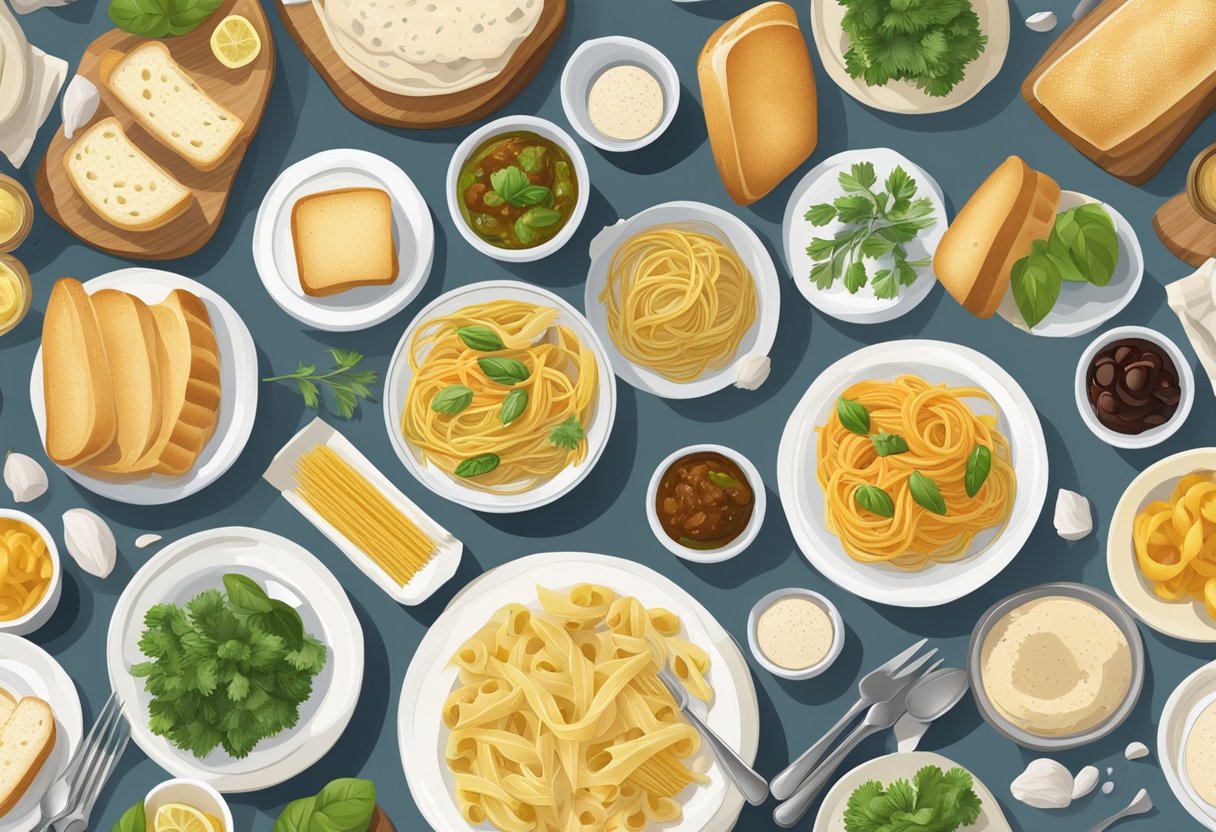
When following a gluten-free Mediterranean diet, dining out requires awareness of menu options and a basic understanding of Mediterranean dining customs to ensure meals remain aligned with dietary needs.
Navigating Restaurant Menus
Restaurants typically have a variety of dishes, but individuals on a gluten-free Mediterranean diet should seek out gluten-free options. Menus usually indicate gluten-free choices, but if not, they should focus on meals that naturally fit the diet—like salad (ensuring no croutons), fish (grilled or baked without flour-based coatings), and vegetarian options. Sides like olives or kalamata olives, and toppings like feta cheese, are generally safe choices.
Mediterranean Dining Etiquette
Mediterranean dining centers on shared eating experiences and fresh ingredients. Diners are encouraged to ask about preparation methods to avoid gluten. Requesting olive oil as a bread substitute can provide a similar dining experience while staying gluten-free. It’s also common to share dishes like a platter with various cheese, including feta, ensuring everyone at the table can partake in a gluten-free Mediterranean diet.
Lifestyle and Sustainable Eating

Adopting a gluten-free Mediterranean diet not only supports health but also encourages a lifestyle that values physical activity and sustainable food practices.
Physical Activity and the Mediterranean Lifestyle
The Mediterranean lifestyle emphasizes the importance of staying active. Regular physical activity is integral, aligning with the diet’s principles for overall well-being. This could include daily walks, leisurely swims, or gardening—activities that are enjoyable and keep one physically engaged.
Sustainability in Food Choices
Sustainable eating within the framework of the Gluten-Free Mediterranean Diet involves a preference for organic and local produce. These choices not only reduce the ecological footprint but also promote the consumption of fresh, nutrient-dense foods. It’s a diet rich in plant-based foods, including fruits, vegetables, nuts, and seeds, which are grown with sustainable practices.
Practical Tips for Long-Term Adherence
For long-term adherence to a gluten-free Mediterranean diet:
- Start with a 28-day Mediterranean diet meal plan to simplify the transition.
- Incorporate a variety of gluten-free grains like quinoa and rice to replace traditional white bread and pasta.
- Utilize leftovers creatively to minimize food waste and ensure a diverse intake of nutrients.
Meal Planning and Preparation
Effective meal planning is vital for maintaining a gluten-free Mediterranean diet. Planning ahead facilitates the inclusion of a wide range of necessary nutrients and helps to avoid the last-minute inclusion of gluten-containing products. Preparing meals in advance and knowing how to properly reheat dishes can make the process more efficient and help uphold an active lifestyle.
Common Pitfalls and How to Avoid Them
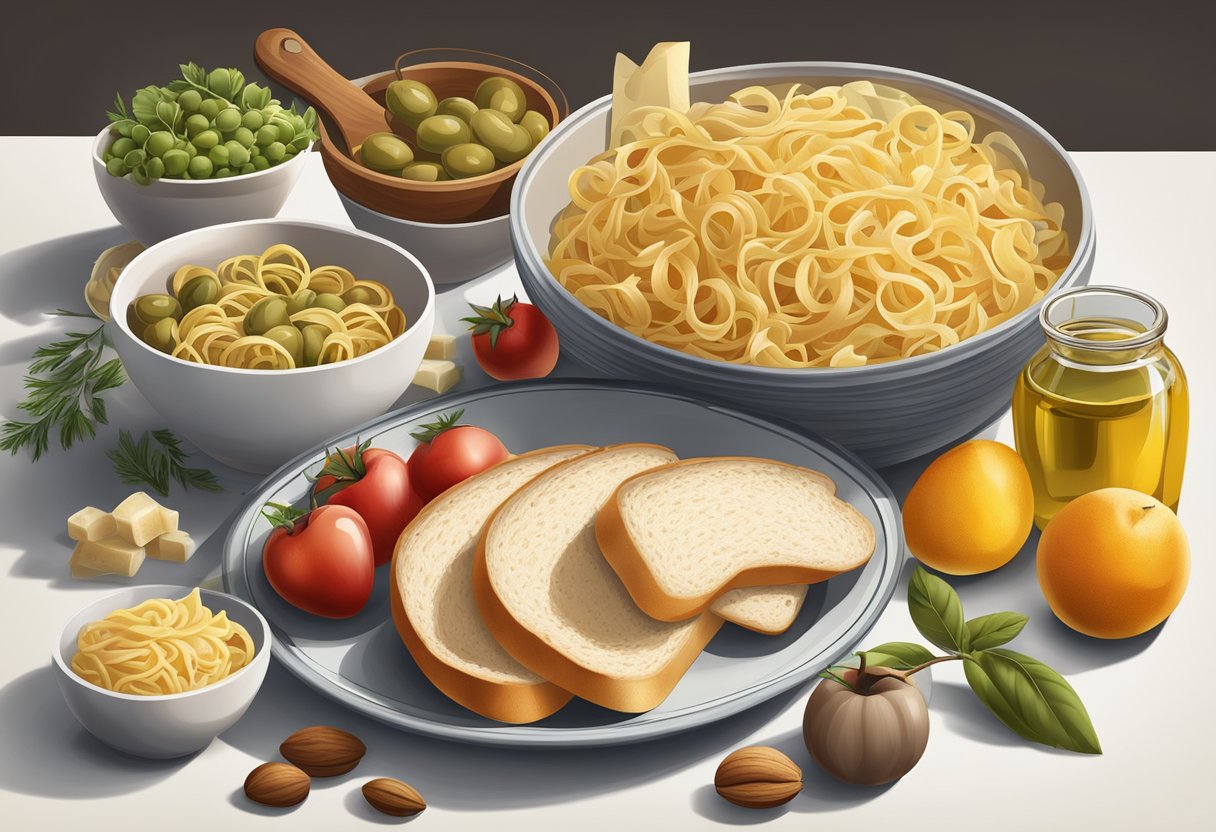
When adopting a gluten-free Mediterranean diet, individuals often face challenges. Understanding these challenges is crucial to maintaining the diet effectively.
Misconceptions about Gluten-Free
One common pitfall is the belief that all Mediterranean staples are naturally gluten-free. It’s important to recognize that while many elements of a Mediterranean diet are gluten-free, such as olive oil, fruits, vegetables, legumes, and nuts, traditional white bread and pasta contain gluten, which can cause serious health problems for those with celiac disease or gluten sensitivity.
- Mediterranean Grains: Opt for grains like quinoa or buckwheat, which are gluten-free alternatives to traditional grains and can replace wheat-based pasta and breads.
- Ingredient Labels: Carefully read labels to ensure that gluten-free pasta and breads do not contain hidden gluten or harmful additives.
Additionally, it’s crucial for individuals to avoid cross-contamination. Even minimal amounts of gluten can cause symptoms in those with celiac disease.
- Kitchen Habits: Use separate utensils and cooking equipment or thoroughly clean them when preparing gluten-free foods.
- Eating Out: When dining out, it’s imperative to ask about the gluten-free options and the steps the kitchen takes to prevent cross-contamination.
Frequently Asked Questions
In addressing the concerns of those on a gluten-free Mediterranean diet, the following questions capture common inquiries related to substituting traditional wheat-based products.
What are some gluten-free alternatives to bread and pasta suitable for a Mediterranean diet?
Gluten-free alternatives to traditional wheat bread and pasta include options made from quinoa, rice, and chickpea flour. These alternatives uphold the nutritional values of the Mediterranean diet while catering to those with gluten intolerance or celiac disease. For example, Mediterranean pasta dishes can be created using chickpea pasta.
How can you incorporate gluten-free grains into a Mediterranean diet meal plan?
One can integrate gluten-free grains such as quinoa, millet, and brown rice into their Mediterranean diet by substituting them for traditional grains in salads, side dishes, and as a base for protein-rich toppings. Utilizing gluten-free oats for breakfast porridge or baking is also a fitting choice for those following this diet.
Can you provide a list of gluten-free Mediterranean diet-friendly foods?
Foods that align well with a gluten-free Mediterranean diet include fruits, vegetables, legumes, nuts, seeds, lean proteins such as chicken and fish, healthy fats like avocados and olive oil, and gluten-free grains like quinoa and brown rice. The diet emphasizes whole foods and minimally processed items.
What are some gluten-free Mediterranean breakfast options?
Gluten-free Mediterranean breakfast options range from hearty oatmeal with fresh fruit to omelets with vegetables like spinach and tomatoes. Breakfast smoothies with almond milk and gluten-free grains or seeds can be a nutritious start to the day.
Where can I find gluten-free Mediterranean diet recipes that also exclude dairy?
Gluten-free Mediterranean recipes that also exclude dairy can typically be found on websites dedicated to gluten-free living and well-being. Such sites may offer a variety of meal plans and recipes catering to these dietary restrictions.
Are there any recommended gluten-free Mediterranean diet cookbooks?
Several cookbooks have been published that focus on gluten-free Mediterranean cooking. One may find a selection of them online or at local bookstores, providing a range of recipes designed for a gluten-free and health-conscious lifestyle.



